1916 Model T Ford Race Car Speedster Roadster Racer Boat Tail Torpedo Rajo Roof
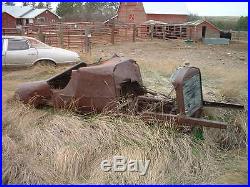
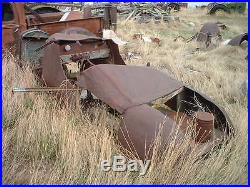
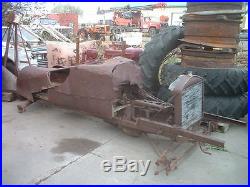
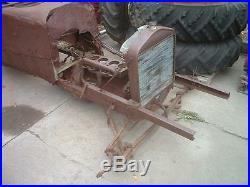

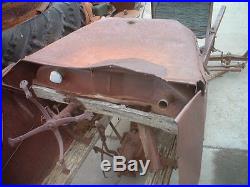
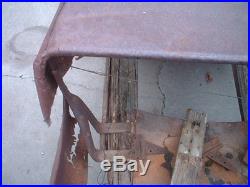
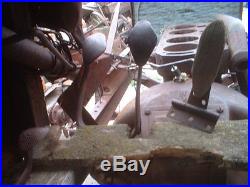
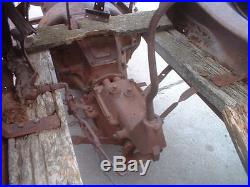
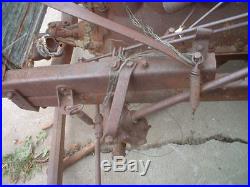
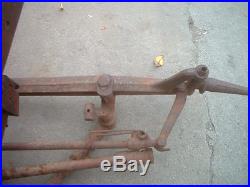
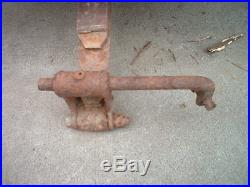

This very unusual and quite interesting Model T Ford speedster or "bug" as they were often called many years ago was very likely built sometime in the late 1920's. It was built on a ranch near Geraldine, Montana by the Goldhahn brothers Harold, John, Chuck and Hank. Jim was the youngest of the 5 boys and may have been involved too in the construction but I rather doubt it. Hank wound up with the home place after WW II and that is who this speedster came from about 20 years ago.
My younger brother Jim now rents Hank's ranch and he and my deceased father hauled it, the remnants of a 1919 roadster and many Model T parts to the home ranch where I was raised about 3 miles away from the Goldhahn place. My father Warren has since passed away and Hank is the only Goldhan boy still living. The 1919 roadster went to Canada a couple of years ago and is now being restored. I was coming from the home ranch with an empty trailer recently and brought this gem along to my current home and shop in Bozeman, Montana.
Some Model T fans have wanted me to part out this gem so they can add some of the best parts from it to their collection. This car is missing the rear axle assembly and all four of the wheels.
I had planned to get a rear axle under it and four wheels on it but most likely will not for quite a while. I realize that this car has a home built body that was not professionally made and is rougher now than it has ever been but it still has a lot of character in it. It is interesting to note that the boys scrounged up some old porcelain signs to use for some parts of the home built speedster body. The procelainized surfaces are hid inside the body.
I believe this car was based on a 1916 touring that the boys' father John Goldhahn bought new and used for the family vehicle until he bought a new Buick touring car in about 1921. That Buick is still on the ranch and I hope to save what is left of it soon.
The engine block in this car has the casting date of 2-22-16. It is interesting to note that all three of the 2's are cast upside down. Someone in the Ford casting pattern shop may have had a tough night before he came to work on February 22 of 1916. The oil pan on this engine is a "needle nose pan" so it very likely is the original one that came on this engine. I remember a 1915 or 1916 T touring car cowl with a hood former in the coulee south of Goldhahn's barn about 35 years ago when I was in high school. I went looking for it many years ago but could not find it then. This car looks and is rough but it has it's own merits too. Please note the factory made lowering brackets still on the rear springs and front axle of this gem. I have a group of original Roof-Laurel advertising sheets and folders and they offered similar brackets as well as every part you could possibly want to build a Model T Ford speedster.I plan to offer reproductions of that very special and interesting literature here soon. Please notice the steering wheel and column.
It appears to be a T wheel mounted upside down on an unknown steering column from some smaller car like an Overland or Chevrolet or whatever. Some ingenious Goldhahn boy wanted a larger steering wheel so they used the rim and outer parts of the spokes from an unknown larger wheel and clamped the whole thing onto the T spider. How ingenious if not so well executed! Another feature on this car that fascinates me are the rear quarters of the body. Judging from the sheet metal work done on the rest of the body, the Goldhahn boys were not experienced sheet metal craftsmen.These rear quarters have matching compound curves so it is very likely that they did not make them so where did they come from? Perhaps the roof of another car from the late 20's or perhaps from the tail end of an old grain combine from that same era or some other piece of farm equipment that I have not yet figured out. Please note that the body has wood sills running the length of the body and the sturdy brackets from another wood framed car body that support the front of the quarter panels and the cowl. Please notice the unknown fuel tank mounted in in the cowl as Ford did in 1926. There is no dash because there were no gauges to mount on one.
I suspect the coil box was on the engine like the later T's. I don't know what was used for an ignition switch. The hood appears to be long gone but it had one because you can see the rear hood hinge support on top of the cowl.Evidently, the hood overlapped the cowl by several inches. Please also notice the auxiliary 3 speed transmission located directly behind the stock T transmission. Please note the several pieces of strap iron that were used to hold this transmission in place.
I doubt they shortened the T drive shaft so I suspect the wheelbase of this gem was longer than stock by the length of this auxiliary transmission. Please note that the T reverse pedal has been removed to make the low and brake pedals easier to use. The T reverse was not needed because one could always use the reverse in the auxiliary transmission. Please notice the early lettered Model T brake pedal that was mounted to the left body sill and likely used to actuate the brakes on the rear axle. It is interesting to note the throttle pedal made from a piece of wood mounted to a t-hinge.Please notice the linkage and rods running up front and through the engine to the Kingston 4 ball carburetor that Ford used in 1913 and 1914. Perhaps there is more of an earlier T still on the Goldhahn ranch but I have yet to find it. One of the things that confuses me the most about this creation is the added on steering gear. The column and gear are from another small or medium sized car and the gear box is mounted on the outside of the left front frame rail. This looks very awkward and puts the entire steering column at an awkward angle in the chassis.
That angle positions the steering wheel much closer to the center of the car than it would normally be. That would be fine if one was building a one man race car but I believe this vehicle was driven to school a lot with at least 2 people in it so there would not have been much shoulder room for both the driver and the passenger.
If you have any idea as to what the steering gear and column, auxiliary transmission and fuel tank are from or have any questions or comments, please let me know. I can find no evidence that this car ever had a deck lid. Dad talked about this Goldhahn "bug" several times because he and his older brother Jim Woodburn built one too. Their T was built more for heavy duty work but they drove it 5 miles to school sometimes because Geraldine had no school bus service until the mid 50's. Dad was 2 years younger than Jim and was more of a helper than an instigator on the project.
He talked about walking a quarter mile to the neighbors and back a lot in order to use their post drill to drill holes in the things he and Jim were building. Evidently it was worth the half mile trip each time because a hand operated post drill worked a lot better than a hand held brace and bit. They took a T chassis with no body and cut the rear cross member off.
They cut about 4 feet off of the rear of another T frame and slipped it into the back of the T frame to make a longer wheelbase. This was done to accommodate the length of an auxiliary 3 speed transmission from an Overland. That Overland transmission came from one of many old junk cars that were lined up at the Geraldine city dump.
Of course those cars were hauled in for scrap and melted during WW II. They used Ford TT 32 x 6 rear wheels and tires on the stock T rear hubs and T rear axle. They also fitted the Overland cowl to the T chassis and used a black T radiator and shell with 1915 front fenders and no hood. They used the steering gear from the Overland to make their bug safer to drive because the stock T steering gear (or lack of one) was such a disaster.
They also built a "5th wheel" hitch on the back and used it to pull a home made trailer to haul rocks out of the fields and haul manure out of the barn yard. I still have most of that T but the rear axle is long gone - likely to some neighbor's grass hopper spreader. My uncle Jim died from strep throat when he was only 19 years old but he was fascinated with mechanical things. Dad talked about the time he and Jim tried to build a perpetual motion machine by putting 2 or 3 engine valve springs inside the combustion chamber of an old single cylinder horizontal engine. I suspect they gave up on perpetual motion soon after that rather interesting first attempt.Jim was not into farming and wanted to study refrigeration which was quite a growing field when he passed away in 1939. There is a large pile of "junk" (can't believe I used that terrible word) at the Goldhahn place that I hope to help clean up next spring and I may find the cowl, hood former and some other parts of the 1916 T touring there. Hank is in his 80's now and has no recollection of what happened to the front spring or rear axle.
I suspect the rear axle was used to build a "grass hopper spreader" which was commonly done and was used to spread wheat bran laced with strychnine to fight the infestations of grass hoppers and "Mormon Crickets" during the tough dry years of the 30's. Dad mentioned several times that Hank's nephew, Bob Anderson, had a nice original 1926 Model T coupe in the early 50's and he may have used the rear axle or front spring from this car to keep that car going.Dad also talked about how Bob cut the roof off of his coupe so he could stand up to drive it. Bob is gone now so I can't verify that story but I can't understand how one might drive a T very well while standing up! Perhaps he wanted no roof on his T so he could shoot rabbits from it? That was back when it was fashionable to wear a fur coat. He used to go hunting with a neighbor, Max VanVoast who also drove a Model T Ford.
They preferred to use two cars so that they had a way to get home when one broke down. Max passed away many years ago so I never got to talk with him about my interest in Model T's.
I asked Hank why the frame was extended in front of the radiator and he had no idea as to why that was done. It may have been used to carry an auxiliary cooling tank but I doubt it because there is no evidence of any plumbing to support that possibility. I suspect someone built a platform out there to ride on and shoot the jack rabbits from. If so, they must have had one hell of a ride in our pastures that are full of rocks, gopher holes and badger mounds.
They mounted a 30 gallon barrel of water in front of the engine when the stock Ford radiator retired. They removed the top material, chicken wire, cotton padding and the bows so they could stand up in the car and shoot at the rabbits. They also took an axe and used it to cut about an 8 inch hole in the body to make a step jut behind the driver's door and just below the body belt line. That way they could step up on the running board and use the crude step to climb into the body of the car. Looking back, I should have bought that pile, made it run and drive and preserved it for the "rabbit hunter" that it was. Please let me know where it is today if you can. I have a somewhat similar Model T race car build on a 1913 chassis that I may also list here soon. I also have a rough Paco speedster body, what I was told is a "Kingston" taper tailed speedster body and another as yet unidentified Model T speedster body that I may list here soon. That body has a rectangular deck lid on a full width deck that tapers down as it goes back. I really like these early racers and speedsters but I acquired a nice original 1911 Model T Torpedo body from a man in Iowa a couple of years ago so I want to concentrate on that project for the next couple of years. That body is in very good original condition with fair original upholstery and the correct top assembly and windshield. I need the special Torpedo frame, the special longer Torpedo steering gear, the special round or somewhat rectangular Torpedo gas tank and would love to find a well used special (about 2 inch longer) Torpedo aluminum hood. I could also use an early front axle with the Dodge Brothers DB logo forged into it, any 1911 engine block, the appropriate oil pan for that block and many other parts.I need a pair of side lamp brackets for that car. I believe they were the same on the Centerdoor sedan, Coupelet and the early coupes that had the backwards opening doors. Those brackets have four mounting holes lined up vertically, two above the lamp mounting hole and two below the lamp mounting hole. Please help me find these parts if you can. The item "1916 Model T Ford Race Car Speedster Roadster Racer Boat Tail Torpedo Rajo Roof" is in sale since Sunday, January 12, 2014.
This item is in the category "eBay Motors\Parts & Accessories\Vintage Car & Truck Parts\Other Parts". The seller is "toysanyone" and is located in Bozeman, Montana.
This item can be shipped to United States.
- Warranty: No
- Country of Manufacture: United States
